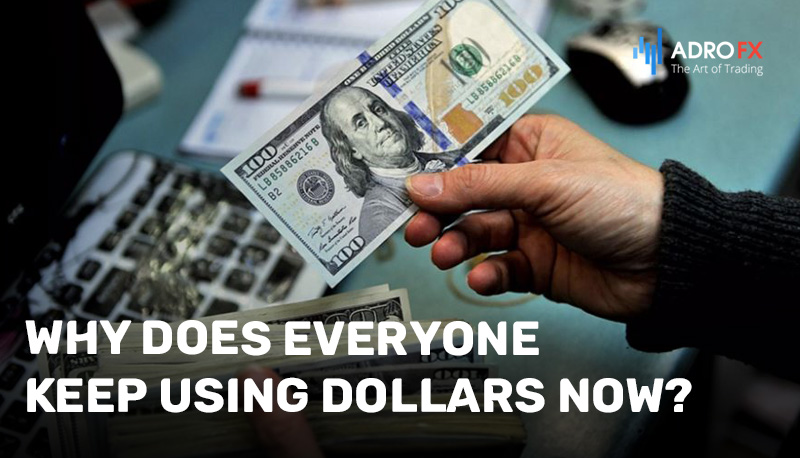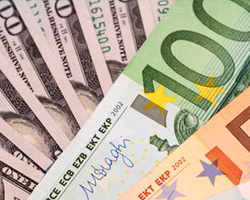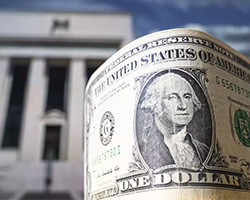The US Dollar Isn't Going Anywhere: How Greenback Became the World's Currency

Before World War II, the British pound sterling was the most powerful currency of the world, due to the large number of colonies and dominions of the British Empire around the globe. Then, the US dollar has become the world's dominant reserve currency, with over 60% of global foreign exchange reserves held in dollars. The dollar's supremacy has been a defining feature of the global economy since the end of World War II. However, the dollar's ascent to its position as the world's reserve currency was not preordained. It resulted from a complex series of historical events, geopolitical factors, and economic policies that shaped the international monetary system in the 20th century.
Reserve Currency Explained
A reserve currency is a currency that other nations use en masse to create their own reserve, to make international payments, as an investment asset, and for other purposes.
Simply put, it is currency that has become a universal means of payment and can be used almost everywhere.
Yet, reserve currency status does not last forever. In the 5th century B.C., the firmest and most popular currency was the Greek silver drachma, then it was replaced by the Roman gold aureus, and then its place was taken by the Byzantine gold solid. That is, the currencies of the most influential and economically developed countries became the reserve currencies.
What makes a reserve currency:
- Stability. The rate of a reserve currency should not be affected by the slightest economic or political change. Investors and transactors mustn't risk losing funds because of fluctuations in its value.
- Free conversion. Reserve currency can be easily and without restrictions converted into other currencies.
- Active involvement in international trade. More than 30% of the finance mass of the currency must be used in the foreign market.
The issuing country must have a free market and a large number of unregulated financial centers. It must also make a significant contribution to world trade.
How the US Dollar Became the World's Currency
To understand why the dollar became the world's main currency, let's look at the history of the 20th century.

At the beginning of the last century, the US budget was in a rather poor condition - in 1913 the foreign public debt of the US was more than $5 billion. This did not prevent the government of the country for 3 years from the beginning of World War I (hereinafter - WWI) to lend its members about $2 billion, with most of these funds going to the purchase of military equipment from the United States.
After America entered the war in 1917, it continued to lend funds to the allies and replenish its budget by selling weapons. By the end of military operations (on November 11, 1918) the debts of European countries to the United States exceeded $10 billion.
WWI was over, it was time to repay debts, and not all countries could meet their obligations. In the spring of 1922, the Genoa Conference participants ( RSFSR, Italy, Great Britain, France, Germany, and the United States as an observer) reached a compromise: repayment of debts was to be made over several decades at the expense of German reparation payments.
In 1923, the monthly inflation rate in Germany, which had first been heavily spent during World War I and was now repaying the victims, reached 3.2 million percent. To stabilize the mark, the German government was forced to turn to the United States for help. Germany received a loan of $200 million - this further strengthened the position of the US currency in the global financial system.
During World War II the USA got hold of part of the evacuated gold reserves of Norway, and in January 1943 the American stores were replenished with Polish, Belgian, Dutch, and French gold recaptured by the allied forces from the Germans.
Since no fighting was taking place on US soil, America prospered against the backdrop of European devastation. The USD was fully backed by gold, meaning bills could easily be exchanged for the metal. Many countries began to form reserves in the US currency as the most reliable and stable in the world.
Officially, the US dollar's position as a global reserve currency was consolidated at the Monetary and Financial Conference of the United Nations in 1944. This event can rightfully be considered one of the most important for the formation of the modern economy.
In addition, the participating countries approved the Bretton Woods monetary system, which was based on equating USD to gold and limiting the emission of notes within the volume of their own foreign exchange reserves. A fixed rate of $35 per troy ounce of the precious metal was set.
The Current Position of the Dollar in the World Monetary and Financial System
In the sixties of the last century, Germany and France wished to exchange some free American bills for gold from the United States. It took 2 years for the USA to exchange nearly three thousand tons of precious metal with Europeans. This gave rise to the rumor that the "world banker" is issuing far more currency than it has gold in its vaults.
It is worth noting that these suspicions were well-founded. America was spending huge sums on the war in Vietnam and the struggle with the Soviet Union for leadership in armaments and space exploration. This quickly led to a significant increase in the national debt.
To achieve its goals, the United States issued dollars unchecked, so by the time creditors began demanding gold owed to them, the US currency had fallen in value so much that the precious metal could literally escape from the treasury like sand through the fingers.
To prevent the final collapse of the economy, American President Richard Nixon announced the abandonment of the Bretton Woods Agreement. The justification was the growth of global financial activity, for which the available gold was not enough.
In 1976 the developed countries adopted the Jamaican monetary system, according to which the exchange rates were set by the market and not by states. The new rules of the game freed up the hands of the Federal Reserve (the central bank of the United States), which could now print as many dollars as needed.
Surprisingly, this did not do much to shake the reputation of the most popular monetary unit in the world. For three decades, everyone has become so accustomed to using USD for international payments that the primacy remains unchanged to this day.
By the way, the transition of the dollar to the status of world currency gave rise to the "Triffin Paradox." According to this definition, the US is condemning itself to the constant balance of payments deficits because it must print enough currency to meet the needs of central banks around the world. It follows that the currency becomes weak...

Why Does Everyone Keep Using Dollars Now?
There are several reasons: the number of dollars in global circulation, the difficulty of counterfeiting them, and US policy. During the Bretton Woods period, a huge amount of US currency was released into global circulation, which for a long time simply could not be replaced. In addition, dollars are difficult to forge: they are made on special paper made of cotton (which is closer in composition to your shirt than to real paper) and printed with a special ink that is made only in the United States.
Finally, by refusing to back its currency with gold, the USA understood that it could cause a collapse of its economy, so it developed a policy to avoid this. America gave Saudi Arabia weapons and protection of oil fields and in exchange the Saudis, and then all OPEC countries undertook to evaluate the oil they extracted exclusively in US dollars.
In addition, we can say that the dominance of the dollar is supported by three elephants:
- "World economic leadership." The US accounts for a quarter of the world economy. No other country has comparable assets and financial infrastructure to provide a currency that participants in international trade would trust. Whether in the 1970s or now, there is simply no worthy alternative to the dollar.
The argumentation of this position deserves a separate article, so we will only say a few words about the main currency competitors of the dollar - the euro and the yuan. Europe since 2008 can't solve its internal financial and political problems, and trying to be a global economic hegemon right now is not only out of time but also unseemly - no one would believe that the European currency can provide half of the world's deals like the dollar does now.
The world's second economy, China, is just beginning to claim global leadership, while the US has been sitting at the top for seventy years. Experience is everything. Especially when you remember how the pound lost its power in its time. Plus, the policy of the Chinese party is too unpredictable and non-transparent for the world community to trust the yuan. The other countries play such a small role in the global economy that it makes no sense to talk about them.
The main economic experts agree with this - the central banks, which continue to choose the dollar among other options, storing most of their monetary reserves in the American currency.
- "Reputation." The US government has defaulted on its loans less often than others. Therefore, its government debt is considered by financiers to be a risk-free investment. Such is the paradox that an obvious bubble continues to be considered the safest investment.
- "Debt Structure." US debt is held mostly by the US government and national companies. Foreign investors own only a quarter of US credit. And it takes wonders of financial acrobatics to default on domestic debts.
Still, despite all the flaws, the US currency remains the most reliable means of payment and the most attractive investment, because the global economy has nothing better to offer.
What About De-Dollarization?
As we have learned from the abovementioned, the dollar has been the leading reserve currency for decades, and its dominance is sustained by the world's first economy, the highest US credit rating, and the network effect of the dollar's extensive use in international trade.
But the further along we go, the more often the dollar's preponderance bulges out in the form of global financial and economic crises, from the Great Recession of 2008 to the outbreak of bank failures in the spring of 2023. Unfortunately, we don't know when the final pop of the inflated bubble will occur. Perhaps not even in our lifetime, but one thing is clear - this is the inevitable course of economic development. There are more and more unsolvable contradictions in the global financial system, and the de-dollarization course looks more and more convincing.
Over the past twenty years, the dollar's share of central banks' international reserves has fallen by 10%. The nearest pursuer, the euro, holds a fifth of the reserves, but the dollar is still the most popular means of payment around the globe
And what will replace the dollar - the yuan, the rupee, a basket of reserve currencies or, God forbid, cryptocurrencies - is an excellent question. And it deserves its own article.
Conclusion
Despite the many challenges that the dollar has faced over the years, including the rise of competing currencies and the erosion of confidence in US economic policy, it remains the world's reserve currency. Its position as a safe haven asset and its use in international trade and finance is unlikely to be supplanted anytime soon. Nevertheless, the dollar's dominance is not inevitable, and the challenges it faces in the 21st century, including rising economic competition and geopolitical tensions, will require continued vigilance and adaptation by policymakers and market participants alike.

About AdroFx
Established in 2018, AdroFx is known for its high technology and its ability to deliver high-quality brokerage services in more than 200 countries around the world. AdroFx makes every effort to keep its customers satisfied and to meet all the trading needs of any trader. With the five types of trading accounts, we have all it takes to fit any traders` needs and styles. The company provides access to 115+ trading instruments, including currencies, metals, stocks, and cryptocurrencies, which make it possible to make the most out of trading on the financial markets. Considering all the above, AdroFx is the perfect variant for anyone who doesn't settle for less than the best.









